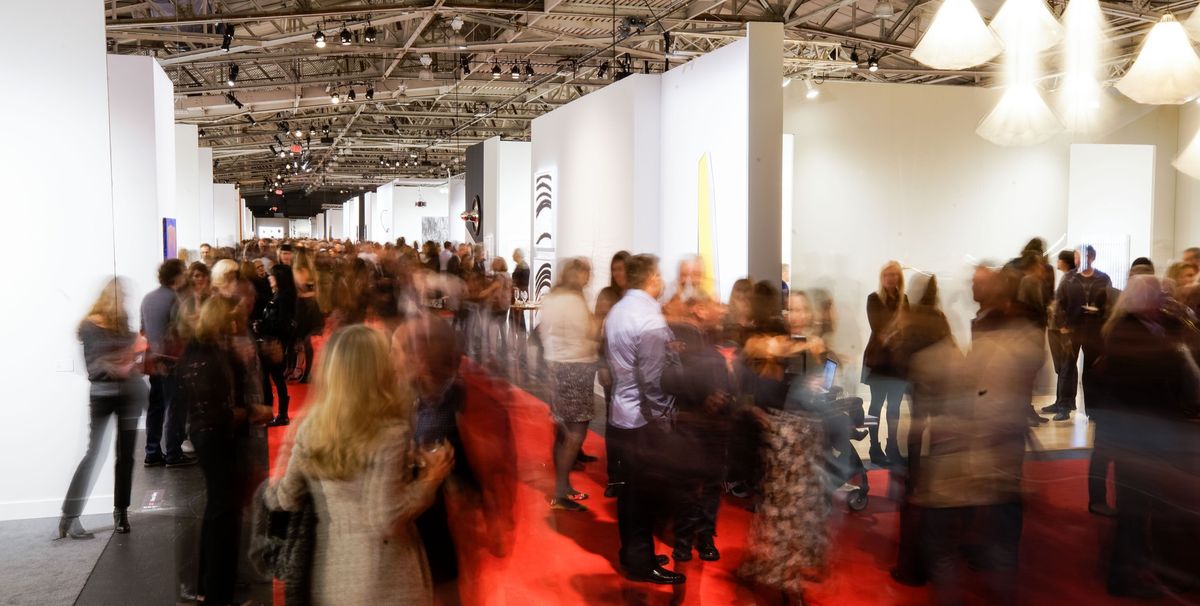They look like a school of jellyfish sinking and rising, or like dancers in diaphanous skirts that billow with each movement. In fact they are strange light fixtures—nine motorised lamps with bulbs dressed in silk shades that flare and contract as they descend on cables from the ceiling. The installation is hard to miss at the entrance of FOG Design + Art Fair which opened today at Fort Mason in San Francisco (until 15 January), the fourth edition of the fair and by many accounts the best yet.
The lamps, designed by Amsterdam’s Studio Drift and wryly called “shylights”, are also a decent litmus test for whether you will like the fair. If you quickly dismissed them as quirky or showy, this is not the fair for you. If you watch for a bit, mesmerised, and move deeper into the booth, where you will find more familiar works from Pace gallery, then you might appreciate an fair that mixes high design and art with abandon.
From the beginning, the driving idea behind FOG has been to use design as a way to make contemporary art more accessible to the Silicon Valley crowd and beyond. In other words, those lamps are not only being shown as art, they are pointing the way to art: a prelude to the Richard Pousette-Dart field painting and Tara Donovan push-pin Minimalist-remake around the corner.
At the VIP opening on Wednesday night, it was hard to tell if collectors were buying anything. Several gallery owners asked about sales flashed a smile and called the night “social”. Translation: a good party but not good business—or at least not yet. As gallerist Jessica Silverman put it, “Serious collectors often start as social collectors.”
And mostly everyone agreed that this fair has better material and better galleries than in years past, anchored by local trailblazers like Silverman, Ratio 3 and Fraenkel Gallery.
The San Francisco Museum of Modern Art curator Gary Garrels said the show has grown dramatically in just a few years. “Early on it was like a toddler trying to find its way. Then it became a gangly teenager. Now it’s all grown up and sophisticated and chic.”
New galleries included Mexico City’s Kurimanzutto, which has a subtly powerful window-inspired wall sculpture by Leonor Antunes and unruly assemblages by Jimmie Durham. Another newcomer, New York’s Lévy Gorvy (the first art fair outing for the recent team-up), has brought a cluster of small works by Yves Klein and a standout rubber-tyre painting by Carol Rama, the Italian artist whose estate they have begun representing. Made from a flattened bicycle tyre on canvas that remains somewhat lumpy, the work echoes that of Lee Bontecou and Eva Hesse, but the medium is particularly emotional since Rama’s father committed suicide after his bicycle factory went out of business.
Blum & Poe, which devoted one wall to small constructions by the Mono-Ha artist Kishio Suga, is participating for the first time since the inaugural edition. It says volumes that they are showing at FOG in San Francisco but no longer take part in Art Los Angeles Contemporary, the fair taking place at the end of January about five miles from their gallery.
That trend also fuels the first edition in San Francisco of the Miami Beach-originated fair Untitled, which has its opening on Thursday night. A total of 10 galleries from Los Angeles are participating, just one fewer than the contingent from the Bay Area. Of these exhibitors—Chateau Shatto, Night Gallery, Anat Egbi, Mier Gallery, Hannah Hoffman, Luis de Jesus, Ghebaly Gallery, Ochi Projects, Harmony Murphy and Overduin and Co—less than half are also doing ALAC.
One prediction: if Untitled succeeds in San Francisco, it will be in no small part because of Los Angeles.


